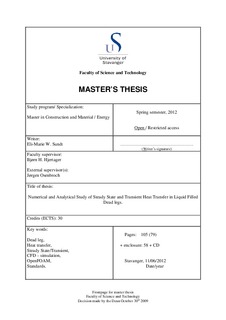| dc.description.abstract | A dead leg is an inactive part of a process pipe, and it has been the cause of serious incidents
due to liquid reaching its threshold value (TV) for freezing. The existing industrial
approach for the design of dead legs is based on rules of thumb and reference standards.
Accordingly, a detailed understanding of the temperature development is not available.
An objective of this thesis is therefore to develop a Computational Fluid Dynamic (CFD)
model in OpenFOAM that can analyse such cases in a more comprehensive matter.
This study is based on investigations of the existing theory and industrial approach. This
is further used to develop a realistic CFD simulation. The results are obtained from two
dead leg geometries. One geometry presents the dead leg as a Fin, while the other geometry
presents the dead leg connected to a main pipe, creating a T-junction. The dead leg
dimensions are based on rules of thumb, namely a diameter of 2" and a length of 0.5m.
This gives a length to diameter ratio (L/D) of approximately 9.
The results are obtained from three cases. Where the Fin geometry is related to Case 01
and the T-junction is related to Case 02 and Case 03. Case 01 and Case 03, are purely
related to heat transfer, both steady-state and transient. The results of these two cases
differs with approximately 10%, indicating that the fin analysis may be sufficient when the
ALARP principle is taken into account. In addition, an analysis is performed to investigate
the effect of wind, which is observed to have a significant effect on the time for water to
reach TV. Case 02 introduces a flow field and turbulence in the T-junction. It is observed
that for a range of velocities, u=1-2,86m/s, the circulation in the dead leg reach L/Di =
4-6 for the respective velocities. This results in a stagnant fluid in the end of the dead leg
as the circulation cease to exist. This effect is reflected in the temperature development,
the result implies almost no heat loss until L=Di = 4.5-6.8 where the temperature falls
rapidly. Consequently, the effect of circulation implies that a design criterion may be
established from further studies. Verification of the CFD-models has been performed by
the use of grid independence test, existing theory and previous experimental results by
Habib et al. | no_NO |
